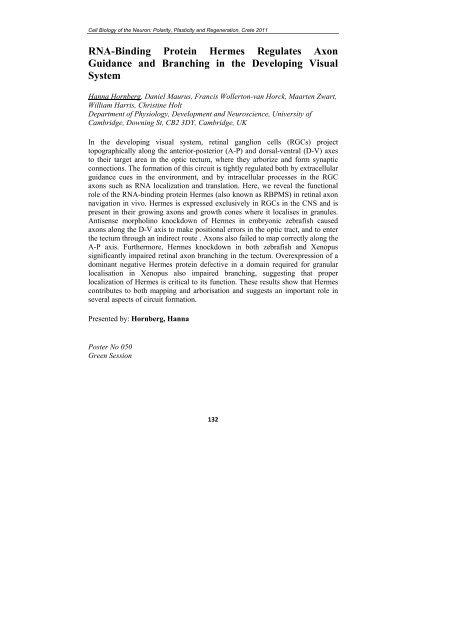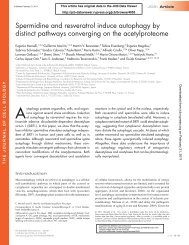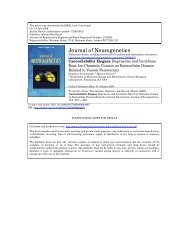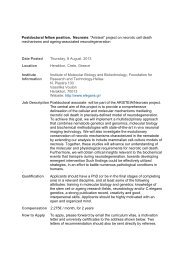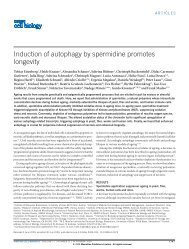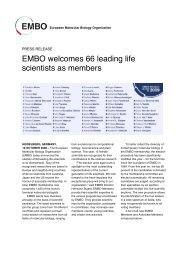CELL BIOLOGY OF THE NEURON Polarity ... - Tavernarakis Lab
CELL BIOLOGY OF THE NEURON Polarity ... - Tavernarakis Lab
CELL BIOLOGY OF THE NEURON Polarity ... - Tavernarakis Lab
Create successful ePaper yourself
Turn your PDF publications into a flip-book with our unique Google optimized e-Paper software.
Cell Biology of the Neuron: <strong>Polarity</strong>, Plasticity and Regeneration, Crete 2011<br />
RNA-Binding Protein Hermes Regulates Axon<br />
Guidance and Branching in the Developing Visual<br />
System<br />
Hanna Hornberg, Daniel Maurus, Francis Wollerton-van Horck, Maarten Zwart,<br />
William Harris, Christine Holt<br />
Department of Physiology, Development and Neuroscience, University of<br />
Cambridge, Downing St, CB2 3DY, Cambridge, UK<br />
In the developing visual system, retinal ganglion cells (RGCs) project<br />
topographically along the anterior-posterior (A-P) and dorsal-ventral (D-V) axes<br />
to their target area in the optic tectum, where they arborize and form synaptic<br />
connections. The formation of this circuit is tightly regulated both by extracellular<br />
guidance cues in the environment, and by intracellular processes in the RGC<br />
axons such as RNA localization and translation. Here, we reveal the functional<br />
role of the RNA-binding protein Hermes (also known as RBPMS) in retinal axon<br />
navigation in vivo. Hermes is expressed exclusively in RGCs in the CNS and is<br />
present in their growing axons and growth cones where it localises in granules.<br />
Antisense morpholino knockdown of Hermes in embryonic zebrafish caused<br />
axons along the D-V axis to make positional errors in the optic tract, and to enter<br />
the tectum through an indirect route . Axons also failed to map correctly along the<br />
A-P axis. Furthermore, Hermes knockdown in both zebrafish and Xenopus<br />
significantly impaired retinal axon branching in the tectum. Overexpression of a<br />
dominant negative Hermes protein defective in a domain required for granular<br />
localisation in Xenopus also impaired branching, suggesting that proper<br />
localization of Hermes is critical to its function. These results show that Hermes<br />
contributes to both mapping and arborisation and suggests an important role in<br />
several aspects of circuit formation.<br />
Presented by: Hornberg, Hanna<br />
Poster No 050<br />
Green Session<br />
132


